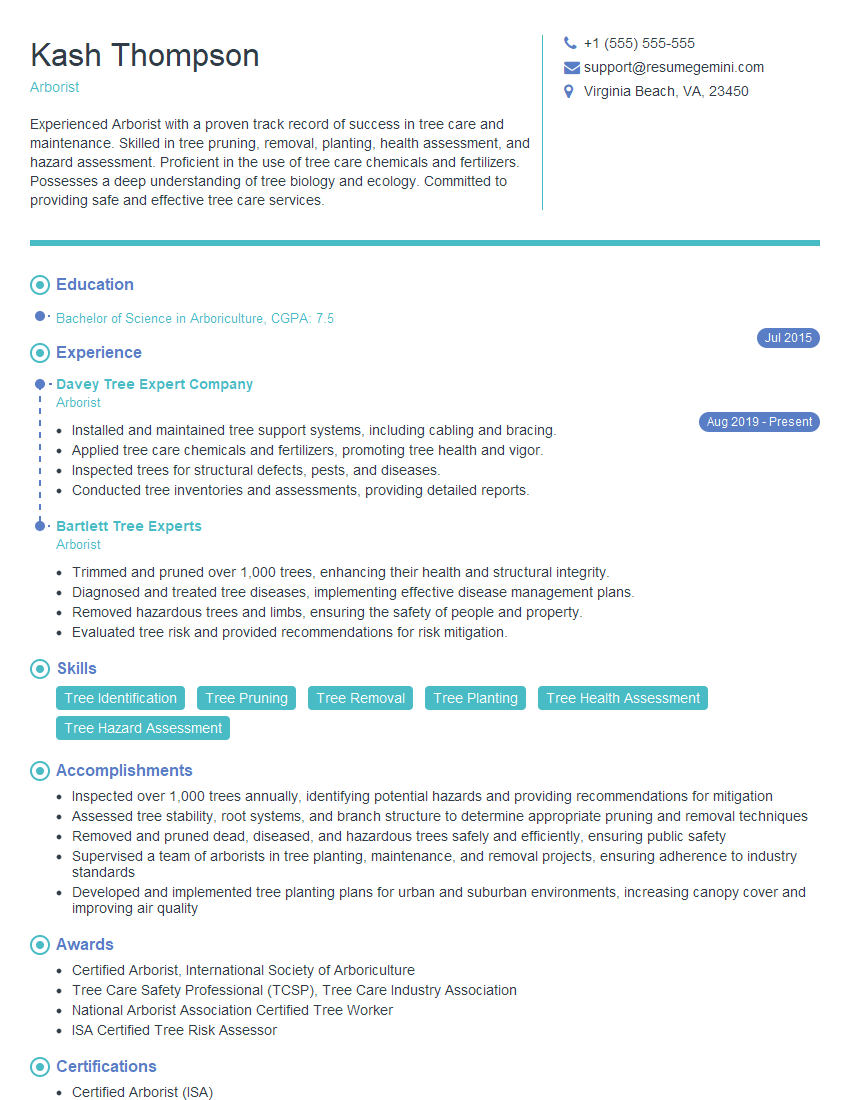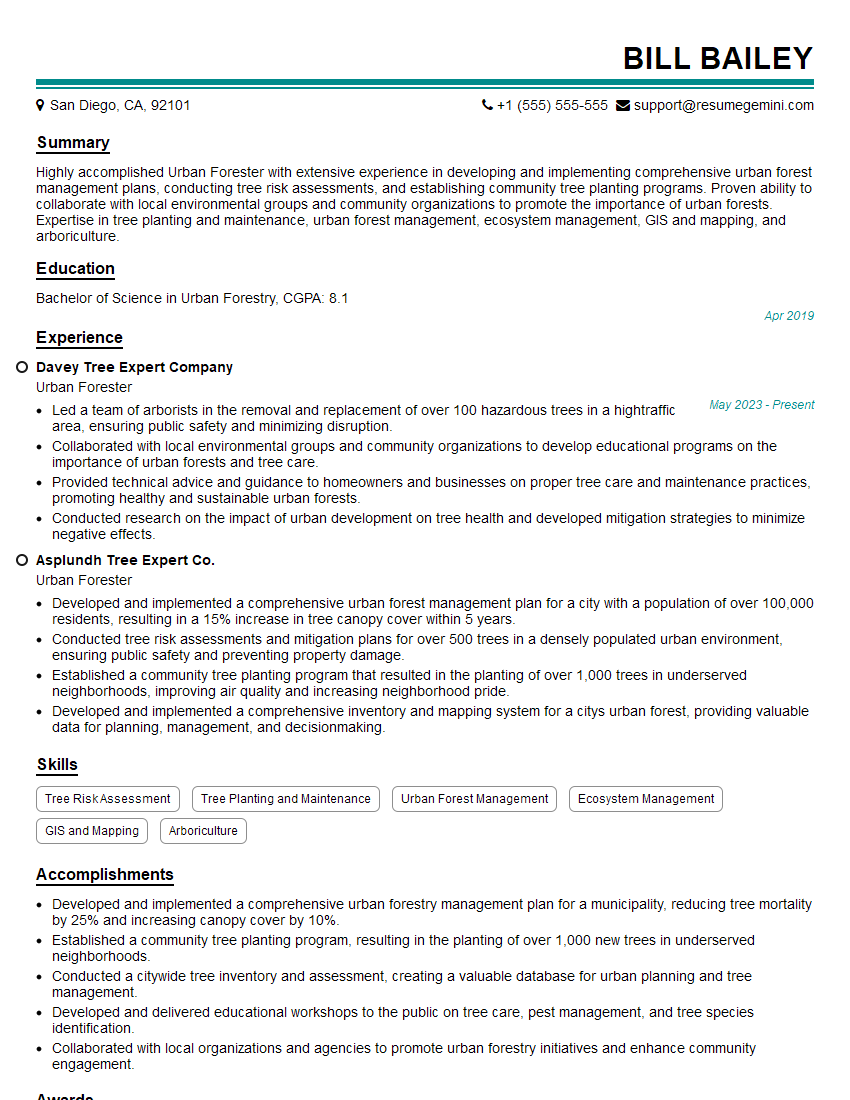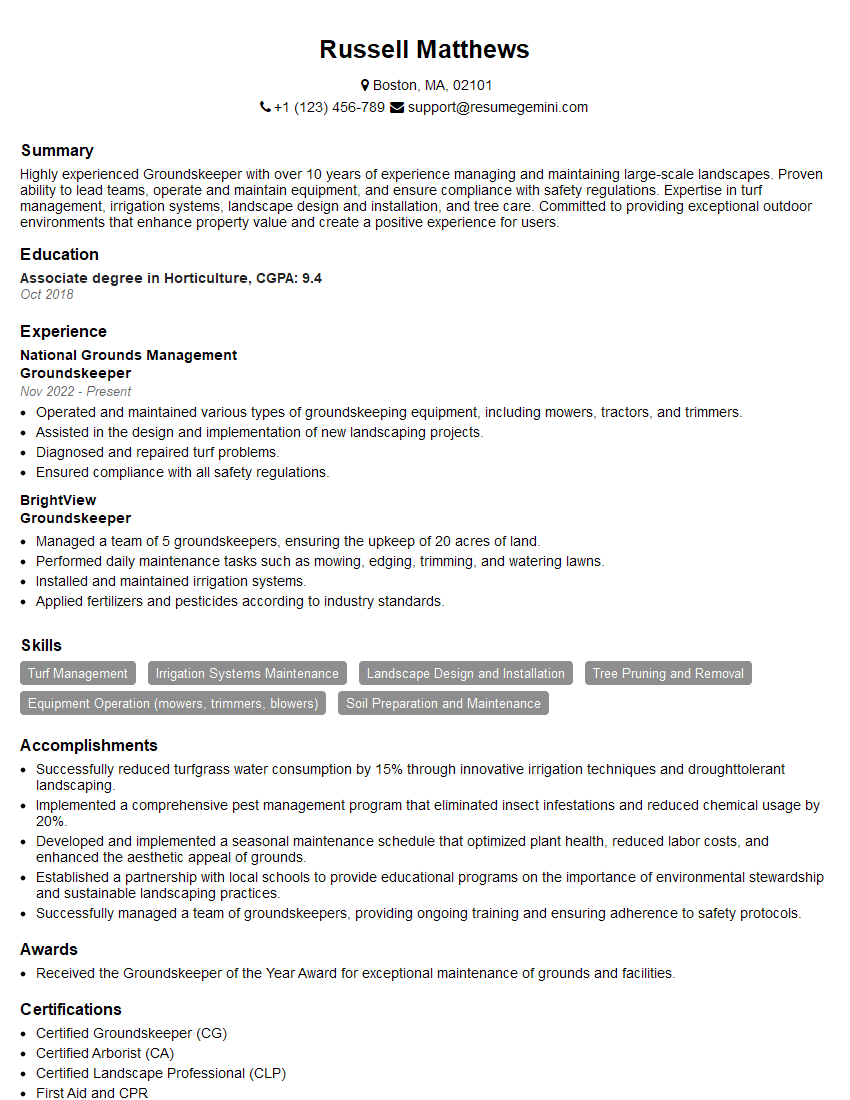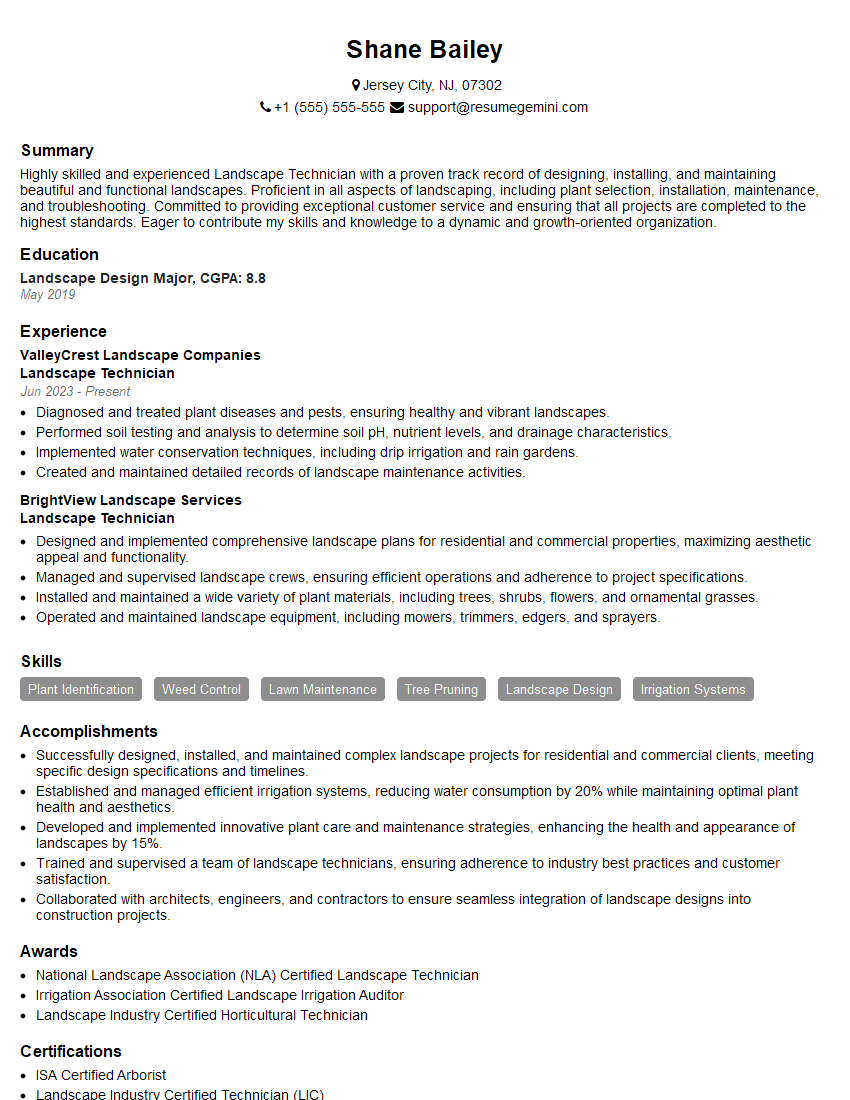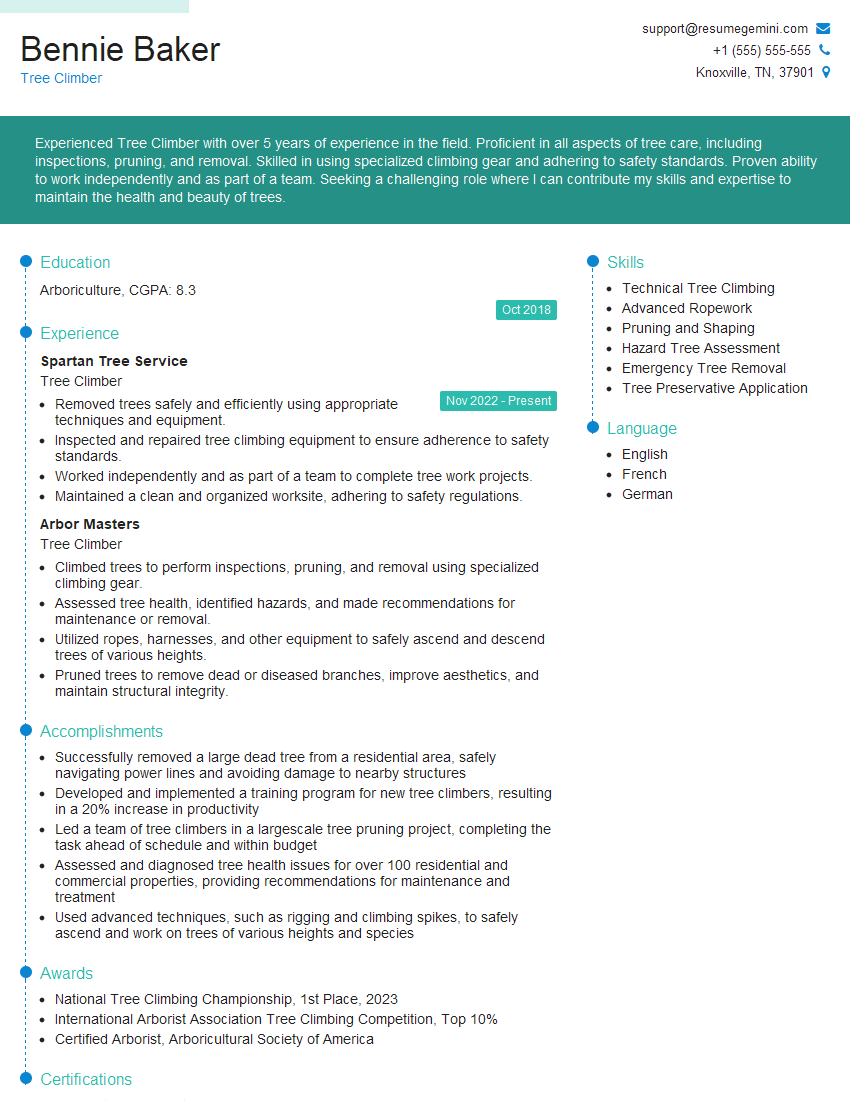Preparation is the key to success in any interview. In this post, we’ll explore crucial Tree Planting and Maintenance interview questions and equip you with strategies to craft impactful answers. Whether you’re a beginner or a pro, these tips will elevate your preparation.
Questions Asked in Tree Planting and Maintenance Interview
Q 1. Describe your experience with various tree planting techniques.
Tree planting techniques vary depending on the species, size of the tree, and site conditions. My experience encompasses a range of methods, from bare-root planting to container planting and balled-and-burlapped (B&B) planting.
- Bare-root planting: This involves planting dormant trees whose roots are exposed. It’s cost-effective but requires careful handling to avoid root damage and ensures planting during the dormant season. For example, I’ve successfully used this method for planting numerous oak saplings in a reforestation project, ensuring proper soil contact and minimizing stress on the roots.
- Container planting: Planting trees grown in containers offers greater flexibility as trees can be planted year-round. This method minimizes transplant shock because the root system remains undisturbed. I frequently utilize this method for landscaping projects, selecting appropriate container sizes based on the tree’s root ball.
- Balled-and-burlapped planting: Larger trees are often planted using this method, where the root ball is wrapped in burlap. Careful handling and proper placement are crucial to prevent air pockets around the roots. I’ve used this technique for larger ornamental trees in park settings, ensuring the burlap is properly removed or loosened to prevent root girdling.
Proper planting depth and appropriate backfilling with amended soil are critical regardless of the planting method. I always ensure sufficient watering after planting to help the tree establish itself.
Q 2. Explain the process of assessing tree health and identifying diseases.
Assessing tree health involves a thorough visual inspection and sometimes more in-depth diagnostic techniques. I begin by observing the overall tree structure, looking for signs of stress such as wilting, discoloration, or unusual growth patterns.
- Visual Inspection: I look for evidence of pests (e.g., insect borers, aphids) or diseases (e.g., fungal infections, cankers). Changes in leaf color, presence of lesions, or unusual dieback are key indicators. For instance, a sudden yellowing of leaves could indicate root rot, while cankers on the trunk or branches suggest fungal infection.
- Soil Analysis: Soil testing can determine nutrient deficiencies or compaction issues that impact tree health. I use soil testing results to make informed decisions regarding fertilization and soil amendment.
- Diagnostic Tools: In some cases, specialized tools may be needed. For example, a resistograph can assess the internal wood condition, and laboratory testing of leaf and branch samples can identify pathogens.
Once a problem is identified, I develop a treatment plan which could involve pruning diseased branches, applying fungicides or insecticides, or implementing cultural practices to improve soil drainage or aeration. Accurate diagnosis is crucial for successful treatment.
Q 3. What are the common tools and equipment used in tree maintenance?
Tree maintenance requires a variety of tools and equipment, ranging from hand tools for smaller tasks to specialized equipment for larger ones. Safety is paramount, and I always use appropriate safety gear, including eye protection, gloves, and hard hats.
- Hand Tools: Pruning shears, loppers, saws (hand saws, bow saws), shovels, rakes are fundamental for most maintenance tasks.
- Power Tools: Chainsaws (various sizes for different tree sizes), pole saws for high branches, brush cutters for clearing undergrowth, and chippers for disposing of pruned branches.
- Specialized Equipment: Aerial lifts or bucket trucks for high pruning or tree removal, specialized cranes for large tree removal, and stump grinders.
- Safety Equipment: Hard hats, safety glasses, gloves, hearing protection, and appropriate clothing are essential for all tree maintenance activities.
The selection of tools depends on the specific task. For example, small branches are pruned with hand shears, while larger limbs might necessitate a chainsaw.
Q 4. How do you select appropriate trees for specific planting sites?
Selecting appropriate trees for specific planting sites is crucial for long-term success. I consider various factors to ensure a harmonious blend of aesthetics and sustainability.
- Climate: Hardiness zones, temperature extremes, rainfall, and sunlight exposure are vital considerations. I ensure that the selected tree species can thrive in the given climate. For example, I wouldn’t plant a tropical tree in a cold climate.
- Soil Type: Soil drainage, pH, and nutrient content influence tree growth. I carefully select tree species suitable to the soil conditions; for instance, certain trees prefer well-drained sandy soil, while others thrive in clay soils.
- Space Availability: Mature tree size – height and spread – is a crucial factor. I select trees that will not outgrow their allotted space, impacting structures or other vegetation.
- Aesthetic Considerations: I take into account the overall landscape design, choosing trees that complement the existing plants and structures while addressing the client’s aesthetic preferences.
Thorough site assessment, coupled with knowledge of various tree species and their specific requirements, ensures that the chosen trees will thrive and enhance the environment.
Q 5. Describe your experience with tree pruning techniques.
Tree pruning is a critical maintenance practice that promotes tree health, safety, and aesthetics. Proper pruning techniques minimize stress on the tree and prevent damage. My experience covers various pruning methods, including:
- Thinning: Removing entire branches back to their point of origin. This improves air circulation and sunlight penetration within the canopy. It’s ideal for reducing density in overcrowded trees.
- Raising: Removing lower branches to increase clearance under the canopy. This improves visibility and allows for pedestrian or vehicle access. I frequently use this method to increase clearance under street trees.
- Reduction: Shortening branches to reduce the overall size of the tree. This is done carefully to maintain the tree’s natural shape and avoid creating stubs that are vulnerable to disease.
- Cleaning: Removing dead, diseased, or damaged branches. This is essential for preventing the spread of disease and improving tree health.
I always employ proper pruning cuts – removing branches cleanly at the branch collar – to minimize damage to the tree and promote rapid healing. I avoid ‘topping’, a harmful practice that can severely damage a tree.
Q 6. Explain the importance of proper soil preparation for tree planting.
Proper soil preparation is paramount for successful tree planting. It significantly impacts root development, nutrient uptake, and overall tree health. Neglecting this step can result in stunted growth or tree failure.
- Soil Testing: Determining the soil’s pH, nutrient content, and drainage capacity is essential. Amendments such as compost, peat moss, or other organic materials can improve soil structure and fertility.
- Removing Obstructions: Rocks, debris, and compacted soil must be removed from the planting hole to ensure proper root expansion. I typically dig a planting hole significantly larger than the root ball, ensuring loose soil for optimal root growth.
- Soil Amendment: Improving soil drainage and aeration is crucial. I often mix organic matter into the backfill soil to provide nutrients and enhance water retention.
- Avoiding Damage: I carefully avoid compaction of the soil around the roots during backfilling, ensuring that the roots have ample space to spread.
Well-prepared soil provides a hospitable environment for the roots, facilitating efficient water and nutrient uptake, and promoting healthy growth. For instance, in clay soils, adding organic matter improves drainage and prevents root rot.
Q 7. How do you handle hazardous tree removal situations?
Hazardous tree removal requires meticulous planning and execution to ensure the safety of personnel and property. I approach such situations with a structured approach:
- Risk Assessment: A detailed assessment of the tree’s condition, location, surrounding structures, and potential hazards is crucial. This includes evaluating factors such as wind, proximity to power lines, and potential for falling branches to cause damage.
- Planning and Preparation: This involves selecting appropriate equipment and personnel, establishing a safety zone, and coordinating with utility companies if power lines are involved. I always develop a detailed plan, outlining each step of the removal process.
- Controlled Removal: This often involves strategic cutting and lowering techniques to control the direction and impact of falling branches or sections of the tree. This may involve using ropes, pulleys, and other specialized equipment.
- Debris Removal: After the removal, safe and efficient debris disposal is important, often requiring chipping or hauling away of the tree parts.
Safety is my top priority. I always adhere to safety regulations and utilize appropriate personal protective equipment (PPE). I also employ qualified and experienced arborists for any task beyond my expertise.
Q 8. What safety measures do you employ during tree planting and maintenance?
Safety is paramount in tree planting and maintenance. We adhere to strict protocols to minimize risks. This includes, but isn’t limited to, wearing appropriate personal protective equipment (PPE) such as hard hats, safety glasses, gloves, and high-visibility clothing. Before starting any work, we conduct thorough site assessments to identify potential hazards like overhead power lines, underground utilities, and unstable ground. We use appropriate machinery and tools, ensuring they are properly maintained and in good working order. For instance, when using chainsaws, we always employ kickback safety measures and ensure the chain brake is functioning correctly. Furthermore, we utilize fall protection systems when working at heights, including harnesses, ropes, and anchors. Finally, we follow established communication protocols within the team to prevent accidents and ensure everyone is aware of ongoing tasks and potential hazards. We always prioritize safe work practices over speed.
Q 9. Describe your experience with tree fertilization and irrigation.
My experience with tree fertilization and irrigation is extensive. I’ve worked on numerous projects, ranging from small residential properties to large-scale urban forestry initiatives. Successful fertilization involves understanding the specific needs of different tree species and soil conditions. We conduct soil tests to determine nutrient deficiencies before applying fertilizers. We then select the appropriate type and amount of fertilizer based on the test results, considering factors like tree age, size, and overall health. Irrigation is crucial, especially for newly planted trees. We employ various methods including drip irrigation, soaker hoses, and sprinkler systems, selecting the most efficient and effective method for each project and considering water conservation. Effective irrigation management helps prevent stress and promotes healthy root development. For example, in one project, we implemented a smart irrigation system that used soil moisture sensors to optimize water usage, significantly reducing water waste while ensuring optimal tree health. This resulted in faster establishment and improved tree growth compared to traditional methods.
Q 10. How do you manage tree pests and diseases?
Managing tree pests and diseases requires a proactive and integrated approach. Regular monitoring is key – we visually inspect trees for signs of infestation or disease, such as discoloration, wilting, or insect activity. Early detection is crucial for effective management. We employ a variety of control methods, starting with the least harmful and escalating only if necessary. This often involves cultural practices such as proper pruning to improve air circulation and sunlight penetration, promoting healthier tree growth. Biological control methods, such as introducing beneficial insects or using microbial pesticides, are also employed wherever possible. When chemical control is necessary, we use targeted pesticides registered for use on trees, always adhering to label instructions and safety precautions. Proper record-keeping is critical, noting the type of pest or disease, treatment applied, and the results. For example, in dealing with a widespread oak wilt outbreak, we used a combination of preventative fungicide treatments, sanitation practices, and strategic removal of infected trees to contain the spread and protect surrounding healthy trees.
Q 11. Explain the importance of tree bracing and cabling.
Tree bracing and cabling are essential techniques to enhance structural integrity, especially in trees with weak branch unions, large canopies, or those exposed to high winds or snow loads. Bracing involves installing rigid supports to strengthen weak branches or stems, often using metal rods or other sturdy materials. Cabling, on the other hand, uses flexible cables to bind together two or more branches or the trunk and a major branch, providing support and preventing breakage. These techniques are often used proactively to prevent damage, but can also be used after damage has occurred to reinforce a partially broken branch. Properly installed bracing and cabling can greatly improve a tree’s longevity and prevent costly damage or injuries. For instance, a large oak tree in a high-wind area might benefit from cabling to reinforce major branches against strong winds, protecting both the tree and surrounding property.
Q 12. How do you determine the appropriate time for tree pruning?
Determining the appropriate time for tree pruning depends on several factors, including the species of tree, its overall health, and the specific goals of the pruning. Generally, the best time to prune most deciduous trees is during their dormant season, late winter or early spring, before new growth begins. This minimizes stress on the tree and reduces the risk of disease. Evergreen trees are typically pruned in late spring or early summer, as pruning during the dormant season can cause excessive sap loss. However, pruning to remove dead, damaged, or diseased branches can be done anytime as needed. Specific pruning goals, such as shaping or reducing size, might influence the timing. We always prioritize the health and safety of the tree when planning pruning activities. We may conduct multiple pruning sessions over a few years to avoid excessive stress.
Q 13. Describe your experience with stump grinding and removal.
Stump grinding and removal are crucial for completing tree removal projects and site cleanup. Stump grinding uses a specialized machine to reduce the stump to wood chips, leaving a relatively small amount of wood below ground level. This is a faster and more efficient method compared to manual excavation. Stump removal involves completely excavating the stump and roots from the ground. This is often necessary in cases where the stump is too large or deeply rooted for grinding, or where underground utility lines are present, requiring careful excavation. The choice between grinding and removal depends on factors such as the size of the stump, the soil conditions, and the intended use of the area. Safety procedures are strictly observed during these operations, including guarding against flying debris and potential contact with underground utilities. Proper disposal of the wood chips and debris is also part of this process.
Q 14. What are the different types of tree planting methods?
Different tree planting methods are chosen based on the size of the tree, soil conditions, and the desired outcome. Bare-root planting involves planting trees without soil around their roots. This method is typically cost-effective for smaller trees and is usually done during the dormant season. Balled and burlapped (B&B) planting involves planting trees with a ball of soil wrapped in burlap. This method is better suited for larger trees and helps protect the root system during transplanting. Container planting involves trees grown in containers. This method allows for planting throughout the growing season and is often used for trees of various sizes. In-ground planting involves planting trees directly into the ground using the method that’s most suitable for the tree and the site. Regardless of the method, proper site preparation, including adequate hole size and soil amendment, is essential for successful tree establishment.
Q 15. Explain the importance of mulching around trees.
Mulching around trees is crucial for their health and vitality. Think of it as providing a protective blanket for the tree’s root system.
- Moisture Retention: Mulch helps retain soil moisture, reducing the need for frequent watering, especially during dry spells. This is particularly important for newly planted trees.
- Weed Suppression: A good layer of mulch effectively smothers weeds, preventing them from competing with the tree for water and nutrients. This reduces the need for herbicides and manual weeding.
- Temperature Regulation: Mulch acts as an insulator, protecting tree roots from extreme temperature fluctuations – both scorching summer heat and freezing winter cold.
- Soil Improvement: As mulch decomposes, it adds organic matter to the soil, improving its structure, aeration, and drainage. This leads to healthier roots.
- Erosion Control: Mulch helps prevent soil erosion around the tree base, especially on slopes or in areas prone to heavy rainfall.
For example, I once worked on a project where we mulched newly planted saplings in a steep hillside. The mulch significantly reduced soil erosion and improved their survival rate compared to unmulched trees.
Career Expert Tips:
- Ace those interviews! Prepare effectively by reviewing the Top 50 Most Common Interview Questions on ResumeGemini.
- Navigate your job search with confidence! Explore a wide range of Career Tips on ResumeGemini. Learn about common challenges and recommendations to overcome them.
- Craft the perfect resume! Master the Art of Resume Writing with ResumeGemini’s guide. Showcase your unique qualifications and achievements effectively.
- Don’t miss out on holiday savings! Build your dream resume with ResumeGemini’s ATS optimized templates.
Q 16. How do you identify different tree species?
Identifying tree species involves a careful observation of several characteristics. It’s a bit like a detective’s work, piecing together clues to reach a conclusion.
- Leaves: Leaf shape, size, arrangement (alternate, opposite, whorled), margin (smooth, toothed, lobed), and venation (pattern of veins) are critical identifiers.
- Bark: Bark texture (smooth, rough, scaly, furrowed), color, and pattern are unique to different species. For example, the smooth, silvery bark of a young beech tree is easily distinguishable from the deeply furrowed bark of an old oak.
- Twigs and Buds: The arrangement of buds, their shape and size, and the color and texture of twigs offer valuable clues.
- Flowers and Fruits: Flowers and fruits, when present, are definitive identifiers. The shape, color, and size of acorns, for example, clearly distinguish oaks from other tree types.
- Overall Shape and Form: The overall crown shape, branch structure, and height can also help in identification. Some trees are naturally pyramidal, others are rounded or weeping.
Field guides, online resources, and apps with image recognition are valuable tools in species identification. I regularly use a combination of these resources along with my experience to accurately identify tree species in my work.
Q 17. What are the common signs of tree stress?
Tree stress manifests in several ways, often subtle at first. Early detection is key for effective intervention.
- Changes in Foliage: Discoloration (yellowing, browning, or bronzing), leaf drop, wilting, or stunted growth can indicate stress. For instance, chlorosis (yellowing) might suggest nutrient deficiencies.
- Branch Dieback: Dying or dead branches, particularly at the tips, often signal problems with water uptake, nutrient deficiency, or disease.
- Bark Damage: Cracks, lesions, or insect infestations in the bark can compromise the tree’s health.
- Changes in Growth Rate: Significant slowing or cessation of growth can be a sign of environmental stress or disease.
- Excessive Fruiting or Flowering: While sometimes positive, this can be a stress response. The tree might be trying to reproduce quickly before succumbing to a problem.
For instance, if I see a tree with significant branch dieback combined with yellowing leaves, I’d suspect either a disease or a root problem requiring further investigation.
Q 18. How do you handle tree damage caused by storms or other events?
Handling tree damage requires a careful assessment of the extent of the injury and the tree’s overall health. Safety is paramount.
- Assessment: First, assess the damage. Is it just a broken branch, or is the trunk compromised? Are there signs of internal damage?
- Safety First: If the damage poses a safety risk (hanging branches, unstable trunk), cordon off the area and contact a qualified arborist or tree removal specialist immediately.
- Pruning: For minor damage, pruning might be necessary. This should be done cleanly with proper tools, following pruning guidelines to avoid further injury. Always make cuts just outside the branch collar.
- Wound Dressing (Debated): The application of wound dressing is a point of contention among arborists. While it might seem beneficial, it’s not always necessary and can even be detrimental in some cases. Research suggests that trees naturally compartmentalize wounds, and dressing can interfere with this process.
- Support: In case of significant trunk damage, bracing or cabling might be necessary to stabilize the tree.
- Disease and Pest Control: If the damage is caused by pests or disease, appropriate treatment should be undertaken.
During a severe ice storm, I once dealt with a large oak tree that had multiple large branches broken. After ensuring the safety of the area, I used proper equipment and techniques to remove the broken branches, ensuring clean cuts to minimize potential infection.
Q 19. Describe your experience with tree inventory and assessment.
Tree inventory and assessment are crucial for effective urban forestry and land management. I’ve extensive experience in conducting both field surveys and analyses.
- Field Surveys: This involves systematically documenting the location, species, size (diameter at breast height or DBH), condition (health, damage), and other relevant attributes of each tree within a defined area. GPS technology and GIS software are widely used to map tree locations and create a comprehensive database.
- Data Analysis: The collected data are then analyzed to assess the overall health and composition of the tree population. This can include identifying species diversity, growth rates, areas needing attention (disease, decay, structural issues), and planning for future tree management.
- Risk Assessment: A key component of the assessment involves identifying trees that pose a potential safety risk due to their condition, location, or proximity to infrastructure. This information informs prioritization for tree maintenance or removal.
- Reporting: The results of the inventory and assessment are presented in comprehensive reports, often including maps, graphs, and recommendations for future management actions.
I recently completed a comprehensive tree inventory for a large university campus, resulting in a detailed report with recommendations for pruning, removal, and planting to enhance the campus’s landscape and ensure the safety of the community.
Q 20. Explain the importance of proper tree planting depth and spacing.
Proper planting depth and spacing are fundamental for successful tree establishment and long-term health. Planting too deep or too shallow, or spacing trees too close together, can significantly impact their growth and longevity.
- Planting Depth: The root flare (the point where the trunk widens at the base) should be visible above the soil line. Planting too deep buries the root flare, suffocates the roots, and weakens the tree. Planting too shallow exposes the roots to desiccation and makes the tree vulnerable to wind damage.
- Spacing: Adequate spacing allows trees to grow without competition for resources like sunlight, water, and nutrients. Crowding leads to stunted growth, weakened trees, and an increased risk of disease. Spacing requirements vary depending on the mature size of the tree species.
Imagine planting a sapling too deep – it’s like burying a person up to their neck; they can’t breathe or grow properly. Conversely, spacing trees too close together is like raising children in a cramped apartment; they’ll struggle to thrive.
Q 21. How do you address tree root problems?
Addressing tree root problems requires careful diagnosis and a tailored approach depending on the nature of the issue.
- Root Girdle: This occurs when roots grow in a circle around the trunk, constricting its growth. It can be caused by improper planting or other root damage. Sometimes, careful pruning of the girdling roots is necessary. This is a complex procedure and should be handled by an experienced arborist.
- Compaction: Compacted soil restricts root growth and oxygen uptake. Aeration techniques, such as core aeration, can help improve soil conditions. I’ve often used this method to help improve the soil around trees that were struggling due to compaction.
- Root Rot: This fungal disease can cause significant damage. Treatment involves improving soil drainage, removing infected roots, and in some cases, applying fungicides. Prevention through proper soil management is key.
- Root Damage from Construction or Other Activities: Protecting tree roots during construction is crucial. This might involve creating root protection zones, and rerouting utilities to avoid root damage.
In one instance, I discovered extensive root girdling in a mature oak tree. Using specialized tools, I carefully pruned the girdling roots, taking precautions to minimize injury to the tree and improve its long-term health. The recovery was slow but successful.
Q 22. What are the regulations and permits required for tree work in your area?
Regulations for tree work vary significantly depending on location. In my area, any work involving trees over a certain size (often defined by diameter at breast height or DBH) generally requires permits. This includes felling, pruning, or significant root work. The permitting process typically involves submitting a plan detailing the work to be done, including tree species, location, proposed methods, and mitigation strategies for potential environmental impacts. There are often specific requirements for protecting nearby structures and utilities. For example, work near power lines necessitates involvement from the utility company and adherence to their safety protocols. Failure to obtain the necessary permits can result in fines or legal action.
Beyond permits, there are also regulations regarding protected tree species. Some trees are legally protected and cannot be removed without special authorization, regardless of size. We must also follow guidelines on waste disposal, with specific rules for the handling of green waste and tree debris. These regulations are designed to ensure environmental protection and public safety.
Q 23. Describe your experience with using aerial lifts and other specialized equipment.
I have extensive experience operating aerial lifts, including bucket trucks and boom lifts, as well as other specialized equipment like stump grinders, wood chippers, and specialized pruning saws. Safety is paramount, so I’m always meticulous about pre-operation checks, ensuring the equipment is functioning correctly and adhering to all safety protocols. I’ve used aerial lifts for a variety of tasks, from high pruning in sensitive areas to safely removing hazardous branches or performing detailed crown reductions on tall trees. My experience extends to working with various lift capacities and boom lengths, adapting to different tree heights and access challenges. For example, on one project, we used a specialized lift with an articulating boom to access a large oak tree overhanging a historic building, allowing us to prune safely without causing damage to the structure.
Using specialized equipment like stump grinders, is also important for efficient and clean site preparation. Understanding their limitations and capabilities, as well as having the skill to operate them safely, is a key element of my expertise.
Q 24. Explain your understanding of tree growth cycles and seasonal considerations.
Understanding tree growth cycles and seasonal considerations is crucial for effective tree care. Trees are living organisms with distinct phases of growth and dormancy. Knowing this helps us determine the best time for pruning, planting, fertilization, and pest and disease management. For instance, the ideal time for pruning most deciduous trees is during their dormant season (late winter or early spring) when they are less susceptible to disease and are better able to heal.
- Spring: A period of rapid growth and leaf development, making it a prime time for planting and fertilization. However, heavy pruning should generally be avoided.
- Summer: Trees are actively growing, requiring regular watering, especially during periods of drought. We might perform some light pruning, focusing on removing dead or diseased branches.
- Autumn: A time of preparation for winter dormancy, with leaf drop. This is a good time for planting and soil improvement.
- Winter: The dormant season is ideal for heavy pruning and other major tree work.
Ignoring these seasonal considerations can severely impact tree health, increasing susceptibility to disease and potentially causing damage. For example, pruning during the active growing season can lead to excessive sap loss and create wounds that are more easily infected.
Q 25. How do you plan and manage a large-scale tree planting project?
Managing a large-scale tree planting project involves meticulous planning and execution. It begins with a thorough site assessment, considering factors like soil type, drainage, sunlight exposure, and existing vegetation. Then, we develop a detailed planting plan, specifying the species of trees to be planted, their location, and the number required. This plan will also consider the long-term growth potential of the trees and any potential conflicts with utilities or structures. We’ll factor in site preparation, including soil amendment and grading. The project schedule must incorporate the appropriate planting season for the selected species. Effective project management includes sourcing high-quality tree stock, securing necessary permits, and coordinating logistics such as equipment and labor. Regular monitoring and maintenance after planting are crucial for ensuring survival and healthy growth of the new trees, particularly in the initial establishment phase.
For example, one large-scale project I managed involved planting over 500 trees along a new highway corridor. We collaborated with the transportation department to establish clear safety protocols, and used GPS-based technology to ensure precise tree placement. Post-planting monitoring involved regular irrigation, mulching, and weed control to optimize tree survival rates.
Q 26. What is your experience with using tree care software or technology?
I’m proficient in using various tree care software and technologies. These tools enhance efficiency and accuracy in many aspects of tree management. I’ve used software for inventory management, where we can track the location, species, size, and health of individual trees. This is especially useful for large-scale projects. Other software can assist in generating planting plans, creating detailed maps for pruning projects, or scheduling maintenance tasks. Mobile applications with GPS capabilities help streamline data collection and field work. The use of drones equipped with high-resolution cameras offers a non-invasive method for assessing tree health and identifying potential issues from a bird’s-eye view. This technology is particularly useful for identifying early signs of disease or damage in tall trees or dense stands.
Q 27. Describe a time you had to solve a challenging tree-related problem.
One challenging situation involved a large oak tree whose root system had significantly damaged a client’s foundation. The obvious solution was removal, but the tree was mature and highly valued by the homeowner. Instead of removal, we developed a multi-pronged approach. First, we used ground-penetrating radar to map the extent of the root system and carefully evaluate the structural damage to the foundation. Then, we consulted with a structural engineer to determine the feasibility of root pruning and foundation repair. We used specialized root pruning techniques to carefully remove parts of the root system that were causing the damage while minimizing harm to the tree. Simultaneously, the foundation was repaired, and we installed monitoring systems to track the tree’s health and the foundation’s stability. This collaborative solution saved the tree and minimized expensive and extensive repairs.
Q 28. How do you maintain accurate records and documentation for tree maintenance?
Maintaining accurate records and documentation is crucial for effective tree maintenance and legal compliance. I use a combination of digital and physical methods. Digital records include electronic databases, spreadsheets, and cloud-based platforms to store tree inventories, inspection reports, maintenance schedules, and treatment records. I utilize GPS technology to accurately map tree locations and record precise measurements. For example, tree size and health are recorded using a standardized format, often including images for visual documentation. Physical records include site maps, photographs, and signed client approvals for work undertaken. All records are carefully organized and stored securely, allowing for easy retrieval and reporting. This detailed documentation helps in tracking tree health over time, facilitating efficient management and ensuring compliance with regulations.
Key Topics to Learn for Your Tree Planting and Maintenance Interview
- Tree Selection and Site Assessment: Understanding appropriate tree species for various climates and soil conditions, proper site preparation, and identifying potential challenges.
- Planting Techniques: Mastering proper planting methods, including digging the right-sized hole, handling root systems, and ensuring adequate watering and soil compaction.
- Tree Watering and Fertilization: Knowing the appropriate watering schedules and fertilization techniques for different tree species and growth stages. Understanding the signs of nutrient deficiencies.
- Pruning and Shaping: Learning proper pruning techniques to promote healthy growth, remove dead or diseased branches, and maintain desired tree shape and structure. Understanding different pruning styles.
- Pest and Disease Management: Identifying common tree pests and diseases, implementing preventative measures, and understanding safe and effective treatment methods. Knowing when to call in specialists.
- Tree Safety and Risk Assessment: Identifying potential hazards associated with trees, including structural weaknesses, disease, and potential damage to property. Understanding safe working practices.
- Equipment and Tool Knowledge: Demonstrating familiarity with common tools and equipment used in tree planting and maintenance, including saws, shovels, and specialized pruning equipment.
- Environmental Considerations: Understanding sustainable practices, minimizing environmental impact, and complying with relevant regulations.
- Problem-Solving and Troubleshooting: Demonstrating the ability to diagnose and resolve common problems encountered in tree planting and maintenance, such as transplant shock, pest infestations, or disease outbreaks.
Next Steps
Mastering tree planting and maintenance opens doors to a rewarding career with opportunities for growth and specialization. A strong foundation in these skills is highly valued by employers. To maximize your job prospects, create an ATS-friendly resume that effectively highlights your qualifications and experience. ResumeGemini is a trusted resource that can help you build a professional and impactful resume, ensuring your application stands out. Examples of resumes tailored to Tree Planting and Maintenance are available through ResumeGemini, providing you with valuable templates and guidance.
Explore more articles
Users Rating of Our Blogs
Share Your Experience
We value your feedback! Please rate our content and share your thoughts (optional).
What Readers Say About Our Blog
Hello,
We found issues with your domain’s email setup that may be sending your messages to spam or blocking them completely. InboxShield Mini shows you how to fix it in minutes — no tech skills required.
Scan your domain now for details: https://inboxshield-mini.com/
— Adam @ InboxShield Mini
Reply STOP to unsubscribe
Hi, are you owner of interviewgemini.com? What if I told you I could help you find extra time in your schedule, reconnect with leads you didn’t even realize you missed, and bring in more “I want to work with you” conversations, without increasing your ad spend or hiring a full-time employee?
All with a flexible, budget-friendly service that could easily pay for itself. Sounds good?
Would it be nice to jump on a quick 10-minute call so I can show you exactly how we make this work?
Best,
Hapei
Marketing Director
Hey, I know you’re the owner of interviewgemini.com. I’ll be quick.
Fundraising for your business is tough and time-consuming. We make it easier by guaranteeing two private investor meetings each month, for six months. No demos, no pitch events – just direct introductions to active investors matched to your startup.
If youR17;re raising, this could help you build real momentum. Want me to send more info?
Hi, I represent an SEO company that specialises in getting you AI citations and higher rankings on Google. I’d like to offer you a 100% free SEO audit for your website. Would you be interested?
Hi, I represent an SEO company that specialises in getting you AI citations and higher rankings on Google. I’d like to offer you a 100% free SEO audit for your website. Would you be interested?
good
